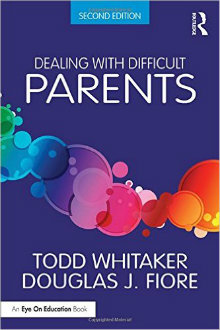How to Deal with Difficult Parents, Revisited
Dealing with Difficult Parents, 2nd Edition
By Todd Whitaker and Douglas J. Fiore
(Routledge/Eye On Education, 2016 – Learn more)
 Reviewed by Holly Foley
Reviewed by Holly Foley
If you have children and are a teacher or administrator, you have been at both sides of the table described in this book at some point. While I prided myself on respecting my own children’s professionals at school, there were a few times in their K-12 experience where the “Momma Bear” in me came out.
As for the other side: for professional reasons (although it is tempting) I will not be telling my own tales out of school about some encounters I had with parents!
 The sources of poor parent/school interaction are identified and preventable alternatives are suggested in this 2016 title Dealing with Difficult Parents by Todd Whitaker and Douglas Fiore. It is a second edition of a title originally published in 2001. In some ways that does show.
The sources of poor parent/school interaction are identified and preventable alternatives are suggested in this 2016 title Dealing with Difficult Parents by Todd Whitaker and Douglas Fiore. It is a second edition of a title originally published in 2001. In some ways that does show.
If I had written this book, there are a few major points I would include that I think were overlooked. But for the most part, this is a valuable resource for conversation and professional development around planning the outcomes of the very important relationship between home and school. (I might stress even more the importance of making sure all of your staff treats and talks to students as if the student’s parent was standing directly behind them!)
The book has a companion workbook, Study Guide to Dealing with Difficult Parents. If the workbook were rich with specific scenario examples, I think it would be more valuable. It is a more of a guided reading resource with room for very open responses that could be equally achieved by just asking the audience to reflect on different parts of the text.
What’s inside the book
There are 5 parts of the book: (1) Today’s Parents; (2) Communicating with Parents; (3) Soothing the Savage Beast; (4) Dealing with Parents in Difficult Situations, and (5) Increasing Parent Involvement.
While Part 1 is rewritten to reflect the 15 years since the first edition, it is so very hard to generalize what “Today’s Parents” are like. I recently switched school systems from a wealthy high performing community to more of a blue collar town, and the parental issues and concerns are truly different. The authors point out that family structure, wealth, and the perception of school as reflected through social media outlets are all factors that have changed, adding more complication and stress to family lives.
The entire vibe of the book is based on a 2001 philosophy that the home phone is going to be the communication tool of choice. Although there is an added social media portion for Part 2, “Communicating with Parents,” I think the book would take a different tack if written today. Yes, I agree a personal contact is preferable – and necessary when dealing with difficult situations and people – but much relationship maintenance can be very effectively managed through electronic means.
“Soothing the Savage Beast,” as you can predict, is the meatiest and best part of the book. The authors explore a lot of varied factors in communication: body language, tone, knowing which parents to call if a group of students are having problem behaviors, what to do if you are feeling defensive, how to handle not having all of the pieces of information when dealing with a story. Overall, excellent considerations and information are found in Part 3!
And Part 4, “Dealing with Parents in Difficult Situations,” further explores some good strategies like how to respond to the “F” word (not the one you thinking) … it’s Fair. As in “that’s not fair to my child.” The authors also handle “my child tells me everything and never lies to me,” and they discuss making rules that make sense, since it is tough to defend decisions based on rules that that don’t make sense.
The main theme is to keep a calm professional tone at all times. The authors give examples of when to ignore comments and when to reiterate phrases in a specific conversation.
The book makes a full circle by recapping how important it is to “Communicate“ with “Today’s Parents,” wrapping the first two parts into the final part, “Increasing Parent Involvement.”
One of my favorite philosophies of the book is the importance of positive interactions. The authors give an example that for every bad write-up, administrators should encourage a “good write-up.” This will coach educators throughout a school to emphasize the positive as well as the negative. A history of positive communication goes a long way when calling a family with problems that need to be addressed.
Editor’s note: A companion volume, A School Leader’s Guide to Dealing with Difficult Parents, is also available.
Holly Foley recently became a Supervisor of Curriculum in a district in Southern Bergen County, NJ. Ironically, she says, this means dealing with parents is a small part of her current job. But after 25 years in K-8 classrooms and raising two young adults, she has plenty of experience in this matter!
































